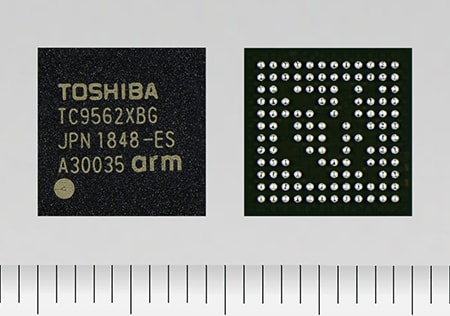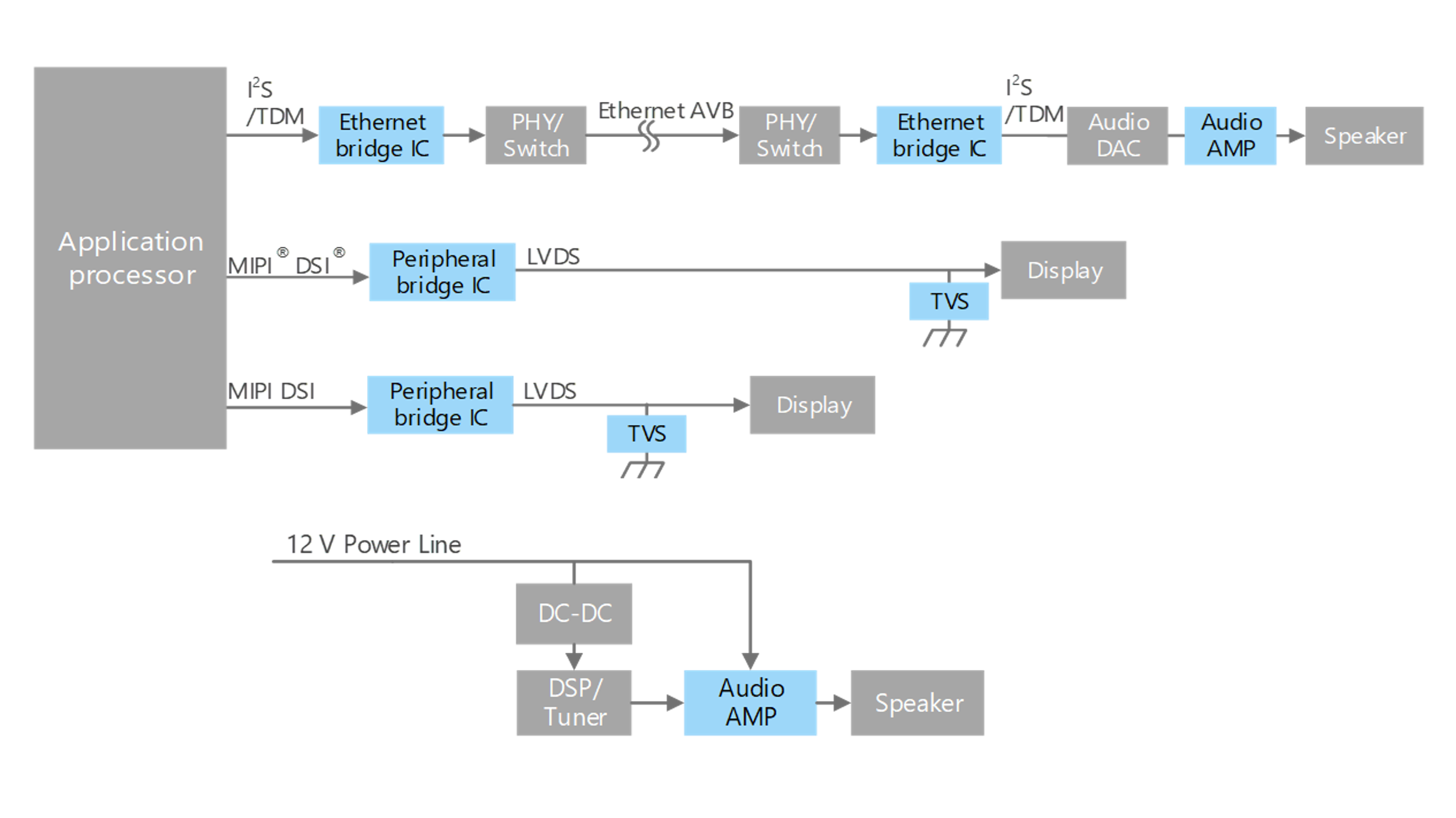Automotive Ethernet Architectures: High-quality in-car audio with Ethernet-AVB/TSN
Introduction
In-car audio has been part of the automotive industry since the car went into mass production, making it one of the first electronic applications in this mostly mechanical world. Road-trip movies are not only defined by the iconic vehicles used and the journeys made; their soundtracks are the glue that not only binds them together but embeds them in our psyche. When viewing a new car, sitting in a showroom, the first feature to test from the driver’s seat is the audio system. It is no wonder that significant effort goes into getting this essential car feature correct.
Car audio systems have moved from mono to stereo, then to surround-sound solutions that immerse the driver in their chosen artist for the duration of their journey. Initially, this followed the same approach as home audio systems, with a central amplifier powering loudspeakers placed around the vehicle. However, the advent of digital networking technologies allowed designers to break this approach, allowing amplifiers to be spread around the vehicle positioned next to the speakers, with digitised audio packets to be directed to each speaker individually.
The introduction of Bluetooth® propelled telephony to a central function of in-vehicle audio, providing another digital audio interface and justifying the move to all-digital audio systems. It also ensured that vehicles would need at least one integrated microphone.
Chapter 1: The status quo

Two technologies have established themselves in this space in the past decade. MOST, the Media Oriented Systems Transport technology, offers a ring topology to which multiple nodes can be attached. Such networks are implemented using Plastic Optical Fibre (POF) or unshielded twisted pair (UTP). This allows the automotive head-unit to communicate with amplifier and microphone nodes located around the vehicle. It also provides enough bandwidth for multimedia implementations, such as video playback. The other is the A2B, a solution focused solely on audio applications. Also using UTP, it distributes I2S audio data together with control data, focusing on the low latency needs of modern audio systems (figure 1).
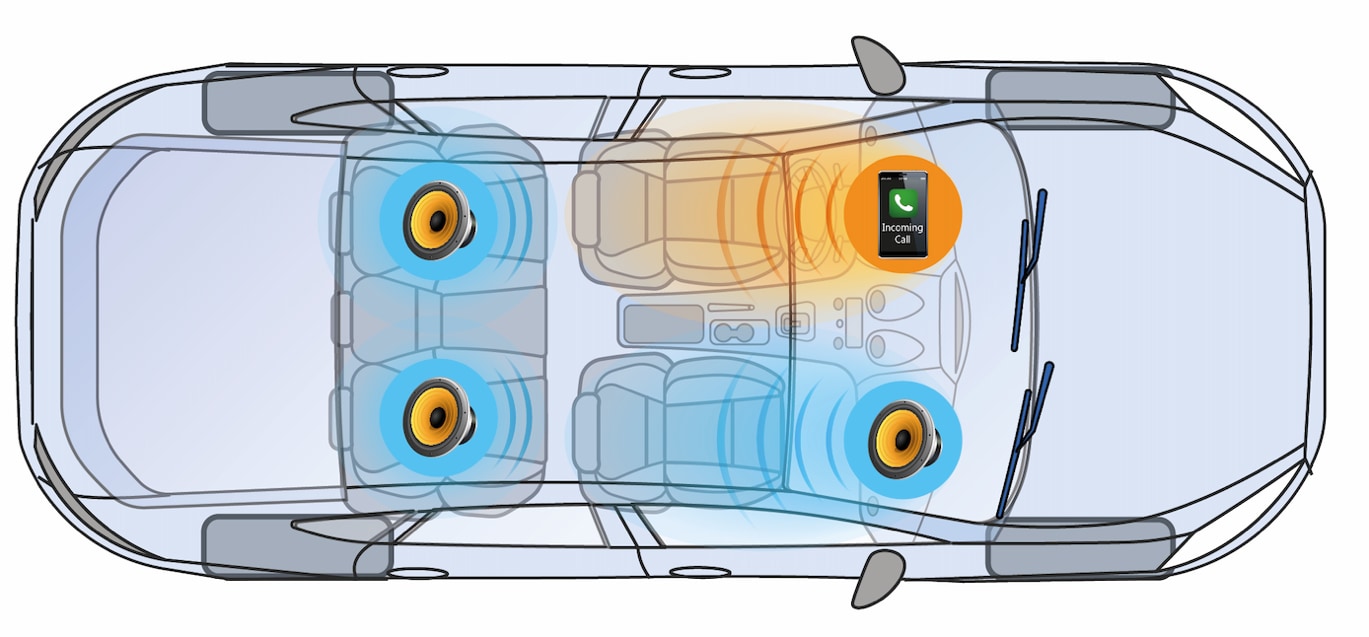
The low latency aspect has become more critical in recent years. Firstly, the ear is less accepting of quality loss than the eye, so audio must be faithfully reproduced without artifacts or drop-outs. Furthermore, applications such as Active Noise Cancellation (ANC) and Road Noise Cancellation (RNC) are growing in popularity. ’Sound Zones’, where each occupant can hear their own personalised audio experience, are also reliant on accurate and stable latencies. Systems today can allow the driver to participate in a phone call while their passengers listen to music with almost no audible bleeding between these two sound bubbles (figure 2). It follows that latency is a key aspect for any technology that wishes to assert itself as a replacement.
While it can be nice to have a choice of technologies to choose from, each new networking solution adds more cost to the cable loom due to wiring and connectors. As one of the top-five most expensive parts of the vehicle, it is obviously beneficial to move to networking technologies that result in cost savings here.
These specific networks and connectivity options also only target multimedia applications, impeding them from being used for the other in-vehicle data-transmission applications.
Chapter 2: Automotive Ethernet and AVB
Like the Ethernet we are used to, Automotive Ethernet is focused on providing IP-address based transport for data rather than concentrating on a specific type of data and its application usage. Its success to date cannot be overlooked, and support from both silicon vendors and the software community can be considered baked-in. To meet the needs of the automotive industry, augmentations have been made that simplify its integration, reduce cable weight, and ensure conformance with tests and standards. It can use a simple, lightweight unshielded twisted pair (UTP) over 15 m cable lengths and the signalling of the physical layer (PHY) has been modified to meet the demands of electromagnetic compatibility. Full-duplex data rates can reach 100 MBits/s or 1000 MBits/s and in future beyond.
Support for specific application needs are provided by extensions to the basic Ethernet standard by AVB/TSN. This allows automotive OEMs to move to Ethernet for a variety of applications, using a single networking technology and wiring system for them all.
To ensure Ethernet can meet the needs of multimedia applications in the vehicle, the Audio Video Bridging, or AVB, standard has been developed. Mechanisms such as stream reservation ensure that, from head-unit to amplifier or microphone to head-unit, the bandwidth required to guarantee latency is always available, regardless of what other traffic may be traversing the same network. To ensure that applications such as ANC and RNC can function, it is essential that all outgoing and incoming audio streams are presented at precisely the same moment in time. This is also critical for the implementation of individual sound zones in the vehicle. This real-time latency is achieved by several specific mechanisms within the AVB/TSN standards.
Chapter 3: A solution for head-unit and end-nodes
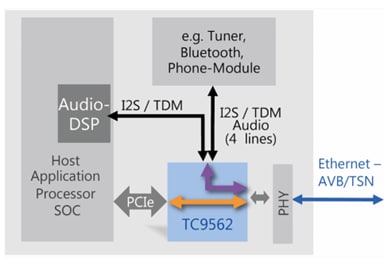
To simplify the implementation of AVB applications, it helps to have a single silicon solution that meets the needs of all nodes on the network. The TC9562 from Toshiba is the latest generation of AVB/TSN-capable devices targeting both AVB applications and supporting Time-Sensitive Networking (TSN) systems. The PCIe interface allows simple integration with the powerful SoCs found in automotive head units, equipping these devices with an efficient AVB-capable interface. Additionally, the integrated Arm® Cortex®-M3 allows the TC9562 to be used as a standalone device and to execute individual audio related implementations. This is ideal for audio nodes with multichannel amplifier outputs and microphone inputs.
For a SoC connection the PCIe Gen 2 interface of the TC9562 supports data rates of up to 5 GT/s (figure 3). However, the TC9562 is significantly more than a simple PCIe-to-AVB bridge. It also has an audio TDM related engine inside including a Media-Clock recovery unit with an own audio-PLL. That can be used in parallel to the PCIe SoC connection.
Digital audio interfaces from tuners, Bluetooth, or other sources can be connected directly to the I2S or TDM interface. From here, the audio data is automatically inserted into and extracted from the Ethernet traffic without any need for the application processor to intervene. In total, up to 32 output channels and 8 input channels or vice versa can be handled via TDM / I2S, with output audio samples of up to 32 bits resolution and up to 24 bits on the input path.
A wide range of PHYs are also supported thanks to support for MII, RMII, RGMII, and SGMII interfaces. Using the Generalized Precision Timing Protocol gPTP (IEEE 802.1AS), this unit can also function as the grandmaster network node. This ensures that all other nodes operate with a common base reference clock. This is essential in maintaining the real-time needed across the system to implement noise cancellation or sound zones.
All the necessary standards for AVB are integrated, such as forwarding and queuing for time-sensitive streams (IEEE 802.1Qav), along with hardware support for the Transport Protocol for Time-Sensitive Applications (IEEE 1722). This ensures that the agreed audio formats are supported along with media clock recovery.
The key point here is, that it is possible to combine audio streams with general data streams over one single Ethernet cable (figure 4). As a result, in many cases it will be possible to use existing Ethernet cables for the audio system. This reduces or even eliminates the need for separate additional digital audio cables and connectors over several different car-audio networking architectures.

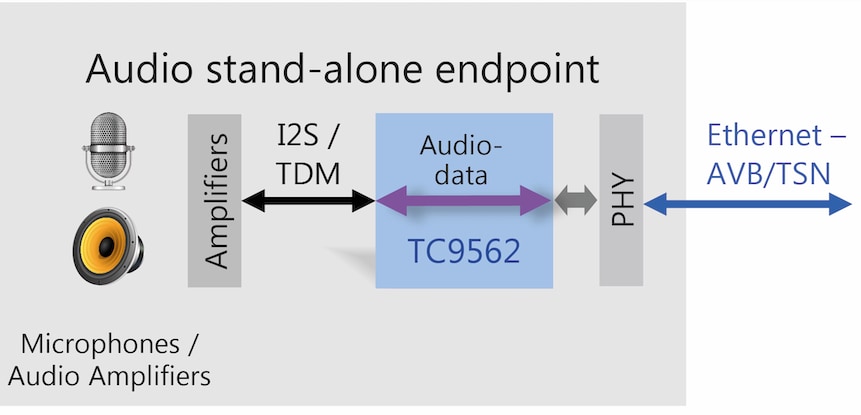
At the audio endpoint, the TC9562 is equally at home (figure 5). The TC9562 ensures that audio data is output or sampled synchronously with all other elements of the AVB audio network. An on-chip Audio Clock Recovery PLL is provided that supports bit clocks of up to 50 MHz to and also from the attached audio devices (output and input of the audio-clock is possible). Key to the simplicity of implementation, the embedded audio-PLL can be operated independently of the TDM / I2S interface. This reduces system complexity and avoids the need for an expensive external PLL solution.
The TC9562 also features a range of other interfaces that help configure and control other devices integrated into stand-alone audio nodes. These include I2C and SPI, both of which can be used to configure the on-board devices such as power amplifiers or codecs, and two UART channels, useful for connection with Bluetooth and GPS modules. System boot is implemented through a fast, 62.5 MHz QSPI interface in the standalone setting, or through PCIe in the host connected case scenario.
The TC9562 device comes with a convenient software API package to allow self-programming of individual car-audio solutions by the customer. This includes a RTOS and Ethernet-AVB stack for the integrated Cortex M3 CPU. Examples and support for the setup of interfacing to individual codec and amp TDM/I2S data formats is available.
Reference links:
Summary
The move to Automotive Ethernet provides vehicle OEMs with the opportunity to unify around a single networking concept that meets the needs of the majority of in-vehicle systems. The UTP cabling is lightweight, replacing a range of POF, LVDS, and other proprietary alternatives. Thanks to the AVB standard, existing Automotive Ethernet networks can also be used to provide connectivity to audio systems without compromising on audio quality, while still being capable of the ultra-low latency requirements of today’s modern noise cancellation and sound zoning technology. The TC9562 is a single device that is equally at home in the head unit or telematics unit as it is in the end nodes. The integrated Audio Clock Recovery PLL is an essential element for the low-jitter synchronicity between all AVB participants and the high-quality audio experience that car owners have come to expect.
Download PDF
Please click the button to download the PDF file.
Related Links
* The Bluetooth® word mark is a registered trademark owned by Bluetooth SIG, Inc.
* Arm and Cortex are registered trademarks of Arm Limited (or its subsidiaries) in the US and/or elsewhere.
* Other company names, product names, and service names may be trademarks of their respective companies.


